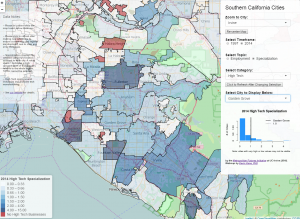This web mapping application e xplores job growth and localized employment specialization at the city level in five key economic sectors: business services, retail, industry, technology, and “creative” work. Note: this webmap presents the same data as the “Employment Subcenters in Southern California” webmap, but for cities rather than subcenters.
xplores job growth and localized employment specialization at the city level in five key economic sectors: business services, retail, industry, technology, and “creative” work. Note: this webmap presents the same data as the “Employment Subcenters in Southern California” webmap, but for cities rather than subcenters.
Category: Quarterly Report
Read published research on Detecting Job Density Over Time
Publication:
Kane, Kevin, John R. Hipp, and Jae Hong Kim. (2016). “Los Angeles employment concentration in the 21st century.” Urban Studies.
Abstract:
This paper is an empirical analysis of employment centres in the Los Angeles region from 1997 to 2014. Most extant work on employment centres focuses on identification methodology or their dynamics during a period of industrial restructuring from 1980 to 2000. We analyse employment centres using point-based, rather than census tract-based employment data and a non-parametric identification method with a single concept of proximity. We focus on changes across five key industries: knowledge-intensive business services (KIBS), retail, creative, industrial and high-tech, emphasising changes in centre composition as well as their boundaries. Results show far greater change across centres than previous longitudinal studies. Only 43% of the land area that is in an employment centre is part of one in both 1997 and 2014. Using a persistence score, centres range from stable to highly fluctuating, but emerging, persisting and dying centres are found in core and fringe areas alike. KIBS are most associated with stable centres, while high tech employment is attracted toward emerging areas and retail exists throughout. Emerging centres are more likely to have greater accessibility, while industrial employment becomes far more concentrated in centres by 2014.
Read the report on Understanding Business Churning Dynamics and their Spatial Variation
While job growth in a region is crucially important, the dynamic of business creation and business closure can reveal a lot about a region’s economy. Does churning lead to “creative destruction” and a more efficient economy in the long-run or might it have negative consequences, especially in certain neighborhoods? This report analyzes business churning at the neighborhood level across Southern California with an eye toward socio-demographic characteristics and local measures of well-being. Download the full report here.
Explore the web app on Understanding Business Churning Dynamics and their Spatial Variation
 Click here for a web mapping application that allows you to explore the relationships between business churning, job growth, and clustering across Southern California.
Click here for a web mapping application that allows you to explore the relationships between business churning, job growth, and clustering across Southern California.
Read published research on Understanding Business Churning Dynamics and their Spatial Variation
Peer-reviewed research based on the analyses in this Report will be published soon. Please return at a later date.
Read published research on neighborhood mixing and economic dynamism
Publication:
Hipp, John R., Kevin Kane, and Jae Hong Kim. (2017). “Recipes for Neighborhood Development: A Machine Learning Approach toward Understanding the Impact of Mixing in Neighborhoods.” Landscape and Urban Planning.
Abstract:
Scholars of New Urbanism have suggested that mixing along various dimensions in neighborhoods (e.g., income, race/ethnicity, land use) may have positive consequences for neighborhoods, particularly for economic dynamism. A challenge for empirically assessing this hypothesis is that the impact of mixing may depend on various socio-demographic characteristics of the neighborhood and takes place in a complex fashion that cannot be appropriately handled by traditional statistical analytical approaches. We utilize a rarely used, innovative estimation technique—kernel regularized least squares—that allows for nonparametric estimation of the relationship between various neighborhood characteristics in 2000 and the change in average household income in the neighborhood from 2000 to 2010. The results demonstrate that the relationships between average income growth and both income mixing and racial/ethnic mixing are contingent upon several neighborhood socio-demographic “ingredients”. For example, racial mixing is positively associated with average income over time when it occurs in neighborhoods with a high percentage of Latinos or immigrants, high population density, or high housing age mixing. Income mixing is associated with worsening average household income in neighborhoods with more poverty, unemployment, immigrants, or population density. It appears that considering the broader characteristics of the neighborhood is important for understanding economic dynamism.